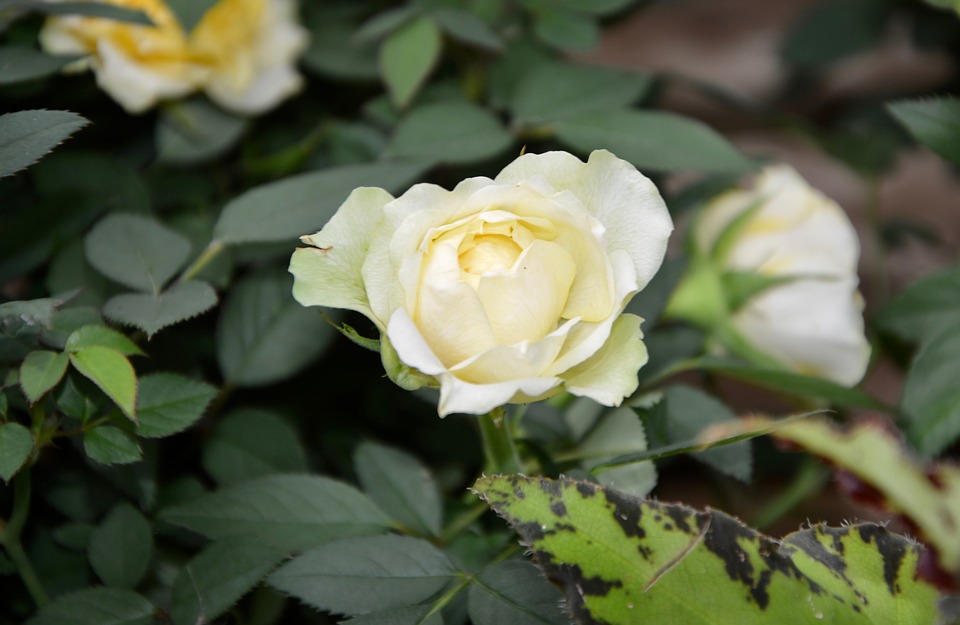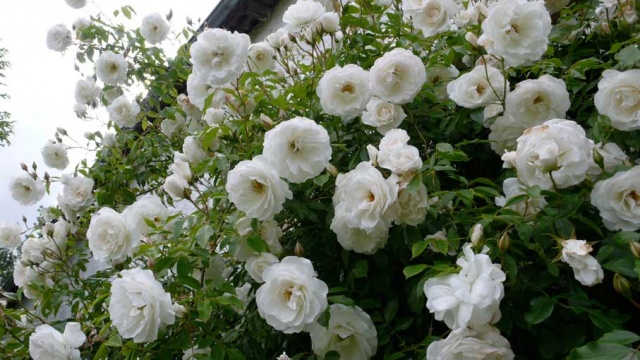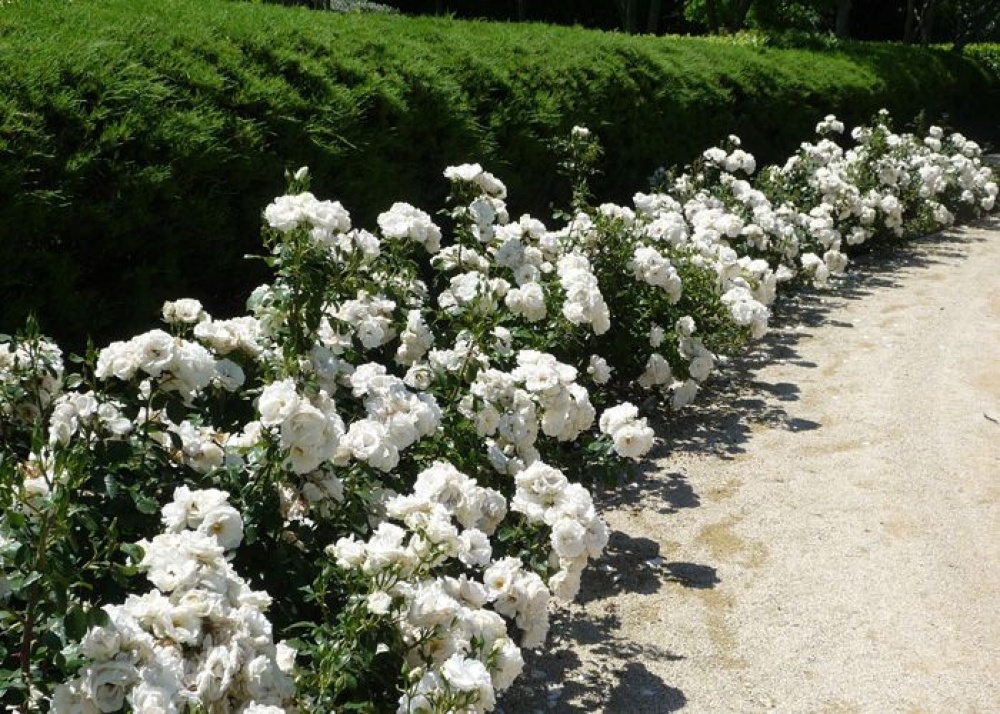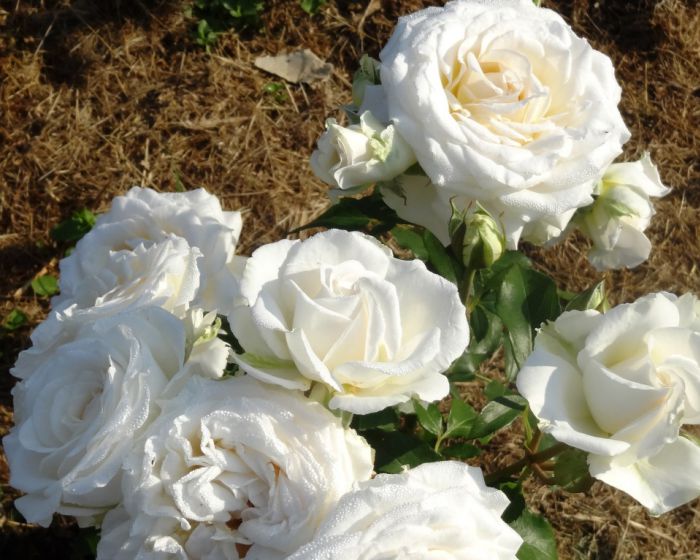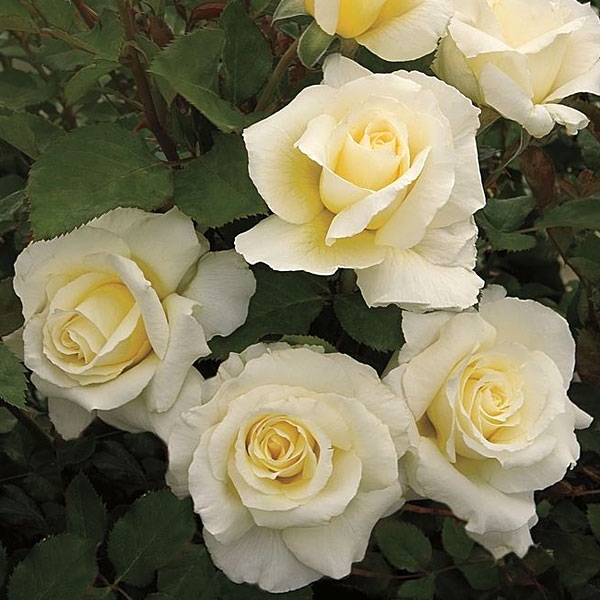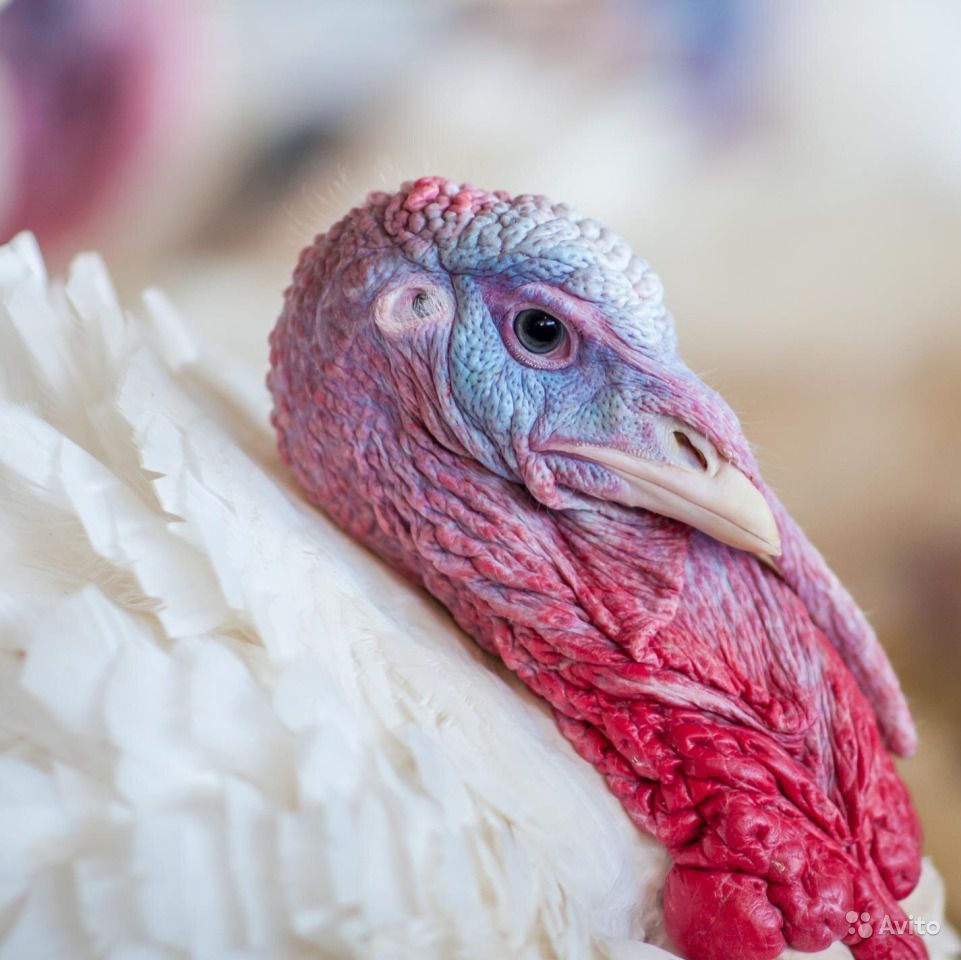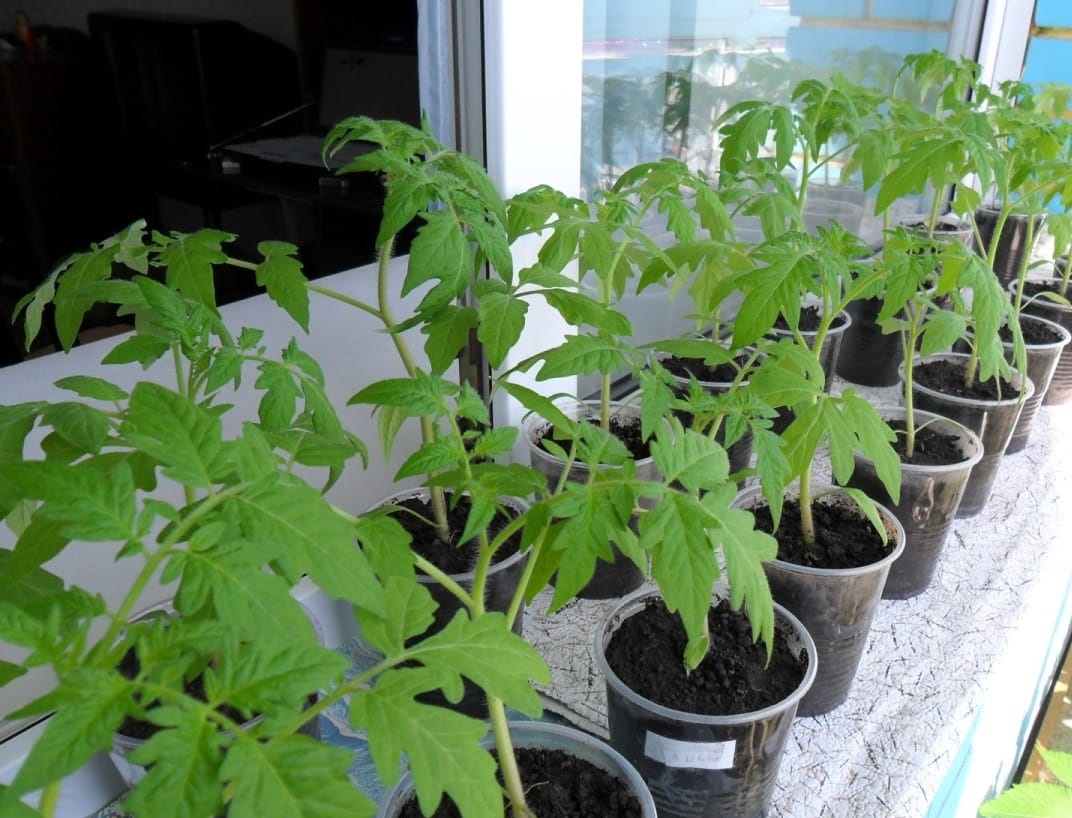Content:
Rose is deservedly considered the "queen of flower beds". Its terry buds, painted in all sorts of colors, cannot leave indifferent any grower. White roses are one of the most popular representatives of this genus. As a result of the work of breeders, many varieties of white roses have been bred. This article presents the classification of white roses, the characteristics of popular varieties, as well as the features of the agricultural technology of this crop.
Description of white roses
The main meaning of these flowers has long been known: a symbol of innocence and purity. In the past, white roses were used to declare love or, conversely, to hint to a girl about her unwillingness to marry. According to scientists, the appearance of white roses dates back to the times of Ancient Egypt and the Roman Empire, when these flowers began to be mentioned in records and used as images.
The flower belongs to the genus Rosehip. The size of the buds varies from small in bush species to large in single flowers. The shape can be spreading and narrow pyramidal. The height of the bush is on average from 25 cm to 60 cm, climbing roses can reach a length of 2-5.5 m. The peduncle can reach a length of 10 cm to 80 cm. The number of petals in a bud varies from 5 to 128. The aroma of the plant is also diverse. , like the varieties of white roses themselves. Here you can find classic Damask aroma, fruity, citrus and spicy notes.
Characteristics of white rose groups
Varietal roses were divided into groups, each of which has its own botanical characteristics:
- Tea-hybrid group of varieties. This group is based on tea and remontant roses. Such roses have a large bud, whose diameter can reach 14 cm. As a rule, there are 1-3 flowers on one flowering shoot. The varieties have branches ranging in length from half a meter to one and a half. It is one of the popular white flower classes and is resistant to most diseases. You should know that the characteristics of hybrid tea roses include a weak resistance to low temperatures.
- Floribunda. Another group of roses, whose advantages include good resistance to rainy and frosty weather, as well as well-known diseases. The floribunda group includes varieties of roses created on the basis of polyanthus and tea. The length of the bush branches can be either 40 cm or 150 cm. Flowers are collected in a kind of bouquet already on the branch. The buds are semi-double or fly type.
- Climbing rose. This class of roses was bred through a long and complex hybridization process. These are the most disease resistant and strongest roses. The shoots of the plant are as long as possible, which makes it possible to decorate arches and fences with them. In addition, the plants are characterized by lush flowering.
- The ground cover variety was obtained by crossing a miniature rose and a climbing one. Often used to decorate flower beds near homes and government offices. These are the most hardy white roses. Flowers are small, abundantly located on long shoots, lashes. The branches of the bush themselves are of the creeping type. Long flowering - from 2 to 4 months.Plants can withstand low winter temperatures under a layer of snow by covering the bush with a cloth.
Each of the four groups has its own varietal list, from which you can choose your favorite variety, which is suitable both for garden planting and as a decoration for the area near buildings. All of these varieties can be used in landscaping.
White rose can be used both as bright accents in the design of a garden or backyard, and as the main component of a monochrome design type.
Agricultural principles of white roses
In order for the flower to have a look that matches its varietal characteristics, it is worth following the rules for planting and caring for plants.
Landing
Agrotechnology of white roses begins with the selection of suitable soil and planting the bushes in the ground. You should choose an open place where sunlight will be available to the plant. In this case, the place must be well protected from the winds.
The acidity of the soil should be at least 5.5 and not more than 6.5 pH. A loamy type of soil is best suited. Experts advise to enrich it with humus, add sand or peat in small doses. If a decision is made to create a full-fledged rose garden with various varieties, each square meter of the root layer should be fertilized with manure in the amount of 19-20 kg.
Planting begins at the end of August. The ground should be warmed up 20 cm deep. The landing pit should have a depth of 65-70 cm.
Care
In growing delicate varieties of roses, not only the correct form of planting is important, but also the care of the plants themselves.
Most often, rose bushes are planted in the fall. In this case, it should be remembered that the plants must be prepared for wintering. They must be piled up and covered with a special cloth.
Nutrition is also an important part of plant care. In the first year of the life of the bushes, it is not recommended to feed them. Further, experts advise annually pruning the bushes and feeding them. The first fertilizer consists of a mixture of manure (3 kg) and ammonium nitrate (20-30 g). The second time to feed the plants is best at the moment when shoots begin to grow. During this period, you should use the special preparation Kemira Universal-2. In the first half of July, both organic and mineral fertilizers are introduced into the "diet" of flowers.
The period of one more feeding falls on the end of August and the beginning of September. During this period, fertilizers based on phosphorus and potassium are used. Typically, this type of feeding is done every two years.
An important element of the rose garden is pruning the bushes. This procedure will improve the decorative qualities of flowers. Pruning is divided into spring, summer and autumn. Strong pruning makes it possible to remove branches to a height of 3-4 buds, medium: from 5 to 7 buds. In turn, a weak pruning of the plant retains 8-15 buds from the level of the base of the stem. According to experts, after pruning, the next 2-3 buds begin to grow actively.
In the spring, pruning of the bush is done immediately after the opening of the overwintered bush. The slice should be positioned 5 mm from the selected kidney. After the unnecessary part of the branch of the bush is cut off, the cut is best treated with a 1% solution of copper sulfate or 3% solution of Bordeaux liquid. This makes it possible to protect the plant from fungal infection.
Pruning done in summer aims to remove the heads that have already faded. This allows the kidneys below to begin to develop more actively. Also, summer pruning can be aimed at forming a certain crown shape.
In the fall, pruning is necessary to remove leaves. It is produced in October. Shoots should be shortened by 1/2 of their length.
Winter is an important period for keeping plants alive. For proper wintering of the bushes, they must be prepared. Hilling should be carried out in September (height 20-30 cm). During dry weather, trimmed plants should be treated for fungal and bacterial infections. Experts advise creating an air-dry type of plant shelter. It can be organized like a small hut.
The plant should be cleaned and opened when the soil warms up by 20 cm.It is during this period that the rose bush can develop independently.
Varieties of white roses: a brief description
Mention should be made of the most popular varieties of rose bushes (each name and characteristics):
White Meidiland rose
The rose was bred in France. It can be used as a ground cover for decorating lawns, flower beds, etc. Terry flowers reach 8.5 cm in diameter, consist of 65-70 petals. The plant is bushy, spreading. The branches are light yellow with large dark green leaves. The advantages of this variety are its high resistance to severe frosts, good tolerance of hot and rainy weather conditions. Rose White Meidiland is highly resistant to diseases of fungal etiology.
Rose White o Hara
This variety of white rose belongs to the peony varieties of the hybrid tea group. The snow-white shade of the petals takes on a creamy shade closer to the core. The diameter of the bud is up to 12 cm, its height varies from 6 to 7 cm. Rose o Hara is suitable for growing in a greenhouse or "winter garden". For good plant growth, a warm microclimate combined with bright shrub lighting is required. The supplier is Ecuador.
Rose White Morsdag
It has a spherical shape of the bud, which makes it original. The petals are milky white. The flowers are small in size, they are of the semi-double type. On a branch, the buds gather in inflorescences. Rose White Mosdag is bushy, its height is normally from 40 to 49 cm, and its width is 65-70 cm. White Morsdag roses have glossy, dark green foliage, which is in harmony with the color of the petals.
Rose White Chocolate
It is a snow-white variety of flowers. The shade can be called "sugar" interspersed with the color of white chocolate at the core of the buds. The chic large flower has become the key to the popularity of the variety around the world. It is one of the representatives of the hybrid tea group of roses. High resistance to low temperatures. The cultivar is highly resistant to diseases such as powdery mildew and black spot, common among rose bushes.
Rose White Sunrise
It belongs to the climbing group of pink plants. The height of the lashes ranges from 2 to 3 m. The buds are large-sized (up to 13 cm), consisting of double-type petals. The plant survives high temperatures, rainy weather, and frost well. High resistance to diseases (powdery mildew, black spot).
Rose White Cloud
A climbing rose, the height can be 1.7-2.4 m. The diameter of the bud after opening reaches 8 cm. The petals of the flower are white in color with a cream shade.
Rose White Knight
Large flowering bush. The bud consists of snow-white petals, the edge of which is outlined by a barely noticeable light green border. Flowers look good in bouquets.
Rose White Licorice
The buds are large, classical in shape. The flower has a rich scent with hints of citrus. The foliage is dark green, semi-clayey. Plants are good at resisting diseases. The height of the bush can be either 80 or 120 cm.
Rose White Bubbles
Shrub rose. On average, one bush gives 3 to 7 shoots with buds. The minimum diameter of the flower is 6.9 cm, the maximum is 8 cm. The bud is formed from 45-50 petals.
Rose White Dragon
Belongs to the class of hybrid tea roses. The height of the bush reaches 65-79 cm, its width, depending on the conditions, can be either 30 cm or 40 cm. The foliage is rich green, matte in appearance. In size, the bowl of the bud is 9 cm in diameter and consists of 45-47 wavy petals. In terms of frost resistance, the variety is characterized by average indicators, while the resistance to diseases is high.
Rose White Lie
It is a representative of spray roses. In height the bushes reach 0.8-1 m. The branches are "strewn" with small double buds.
These varieties of white roses are especially popular with flower growers for their unique color, as well as resistance to bad weather and diseases.
From each group of roses, you can choose varieties with snow-white buds. This means that lovers of white roses can decorate not only a flower bed with these flowers, but also decorate a gazebo, a fence or a wall of a building.
